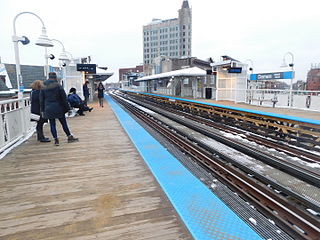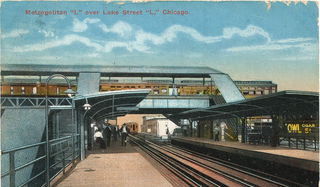
The Chicago Transit Authority (CTA) is the operator of mass transit in Chicago, Illinois, United States, and some of its surrounding suburbs, including the trains of the Chicago "L" and CTA bus service. In 2022, the system had a ridership of 243,538,700, or about 792,100 per weekday as of the first quarter of 2023.

The Chicago City Railway Company (CCRy) was an urban transit company that operated horse, cable, and electric streetcars on Chicago's South Side between 1859 and 1914, when it became merged into and part of the Chicago Surface Lines (CSL) metropolitan-wide system. After that time it owned electric streetcars, along with gasoline, diesel, and propane – fueled transit busses. Purchased by the government agency Chicago Transit Authority (CTA) in 1947, it was liquidated in 1950.

The Fox River Trolley Museum is a railroad museum in South Elgin, Illinois. Incorporated in 1961 as R.E.L.I.C., it opened in 1966 and became the Fox River Trolley Museum in 1984.

Grand, is an "L" station on the CTA's Red Line. It serves Navy Pier, which is accessible via bus on Illinois Street one block south.

California is a station on the Chicago Transit Authority's 'L' system, serving the Blue Line, From California, trains run every 2–7 minutes during rush-hour periods, and take 12 minutes to reach the Loop.

Western is an elevated rapid transit station on the Chicago "L"'s Blue Line, where it is located on the O'Hare branch. The station, opened in 1895, is located within the Bucktown neighborhood in the larger Logan Square community area. It has two side platforms at track level with a station house at street level.

Damen is a rapid transit station on the Chicago "L", currently serving the O'Hare branch of its Blue Line. Opened on May 6, 1895, as Robey, it is the oldest station on the Blue Line. The station serves the popular Bucktown and Wicker Park neighborhoods, and is consistently in the top 40 highest-ridership "L" stations. It has two wooden side platforms and a brick station house at street level. The west platform, serving southbound trains, contains a tower that has never been used but is a relic of the station's past. The station is served by three bus routes on Damen, Milwaukee, and North Avenues, which are each descended from streetcar lines on those streets in the early 20th century. The Blue Line has owl service; while the surrounding streetcar lines also had owl service in the early 20th century, the modern bus services do not.

The Third Avenue Railway System (TARS), founded 1852, was a streetcar system serving the New York City boroughs of Manhattan and the Bronx along with lower Westchester County. For a brief period of time, TARS also operated the Steinway Lines in Long Island City.
The Chicago and Joliet Electric Railway, or C&JE, was an electric interurban railway linking the cities of Chicago and Joliet, Illinois. It was the only interurban between those cities and provided a link between the streetcar network of Chicago and the cities along the Des Plaines River Valley in north central Illinois, which were served by the Illinois Valley Division of the Illinois Traction System.

Madison Street is a major east–west street in Chicago, Illinois. Prior to human intervention, the Chicago River emptied into Lake Michigan at the present day intersection of Madison Street and Michigan Avenue.

Ashland Avenue is a north-south street in Chicago, in whose grid system it is 1600W. It is 2 miles (3.2 km) west of State Street, the city's north-south baseline. It is one of the major streets on the city's west side.
In 1900, Chicago already had the second largest cable car network in the United States and would eventually surpass New York City to have the largest streetcar network in the world in a few decades. In 1900, there were three private companies operating 41 miles (66.0 km) of double track routes radiating out from Chicago's downtown area. State of the art technology when the first line opened in 1882, by 1900 electric traction had proven superior and in 1906 all cable routes were changed to electrical power. Decades later, most were part of Chicago Transit Authority bus routes.

Logan Square was an elevated station on the Chicago Transit Authority's 'L' system, serving the Logan Square branch and the Logan Square neighborhood.

The Lake Street Transfer station was a rapid transit station on the Chicago "L", serving as a transfer station between its Lake Street Elevated Railroad and the Logan Square branch of its Metropolitan West Side Elevated Railroad. Located where the Logan Square branch crossed over the Lake Street Elevated, it was in service from 1913 to 1951, when it was rendered obsolete by the opening of the Dearborn Street subway.

Marshfield was a rapid transit station on the Chicago "L". Constructed by the Metropolitan West Side Elevated Railroad, it was the westernmost station of the Metropolitan's main line, which then diverged into three branches: the northwestern Logan Square branch, the western Garfield Park branch, and the southwestern Douglas Park branch. The station was in service from 1895 to 1954, when it, alongside the main line and the Garfield Park branch, was demolished to make way for the Eisenhower Expressway and rapid-transit Congress Line in its median. In addition to its use on the "L", Marshfield was served by the Chicago Aurora and Elgin Railroad (CA&E), an interurban that used the Garfield Park branch and main line's tracks, between 1905 and 1953.

Madison was a rapid transit station on the Chicago "L"'s Metropolitan West Side Elevated Railroad, serving its Logan Square branch from 1895 to 1951. The station was typical of those constructed by the Metropolitan, with a Queen Anne station house and two wooden side platforms adjacent to the tracks. For much of its existence, Madison served the nearby sports arena Chicago Stadium.
Division was a rapid transit station on the Chicago "L"'s Logan Square branch, one of several branches of the Metropolitan West Side Elevated Railroad. Located on Division Street, the station was constructed by the Metropolitan in the early 1890s and began service on May 6, 1895.
Chicago was a rapid transit station on the Logan Square branch of the Chicago "L", one of the several branches of the Metropolitan West Side Elevated Railroad, between 1895 and 1951. Located on Chicago Avenue, the station was constructed by the Metropolitan in the early 1890s and began service on May 6, 1895.
Grand was a rapid transit station on the Chicago "L"'s Logan Square branch, one of the several branches of the Metropolitan West Side Elevated Railroad. Located on Grand Avenue, the station was constructed by the Metropolitan in the early 1890s and began service on May 6, 1895.
















